 |
 |
 |
| |
Quality of Life, Productivity, and Activity Impairment Among US Survey Respondents With Hepatitis C: An Evaluation of HCV and Six Select Medical Conditions
|
| |
| |
"The HCV cohort was observed to have the second lowest MCS
scores......Numerically, the HCV cohort had one of the highest reported overall work impairment scores (29.5%)"
Reported by Jules Levin
DDW; Digestive Disease week May 4-6, Chicago, ILL
Jamie B. Forlenza1; Jessica Lopatto1; Kathy Annunziata2; Nikoletta Sternbach2; Deborah Freedman3; Neeta Tandon1
1Janssen Scientific Affairs, LLC, Titusville, NJ; 2Kantar Health, Princeton, NJ; 3IMS Health, Plymouth Meeting, PA
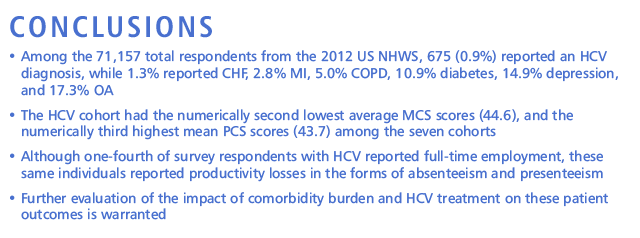
Cohorts were descriptively evaluated for observed self-reported QOL (SF-36v2) and productivity
and activity impairment (WPAI) assessments
- The Medical Outcomes Study 36-Item Short-Form Survey Instrument (SF-36v2)11 is a
validated health survey composed of 36 items assessing eight health domains (vitality,
physical functioning, bodily pain, general health perceptions, physical role functioning,
emotional role functioning, social role functioning, and mental health) summarized into
a physical component summary (PCS) and a mental component summary (MCS) score
(PCS and MCS scores were normed to the United States, with higher scores indicating
greater QOL)
- The Work Productivity and Activity Impairment (WPAI)12 questionnaire was used to measure
the impact of health on work performance. The WPAI is a validated instrument and has a
7-day recall period. From the WPAI, absenteeism (the percentage of work time missed),
presenteeism (the percentage of time when working that productivity is impaired), overall
work impairment (a combination of absenteeism and presenteeism), and total activity
impairment (the percentage of impairment in daily activities) because of one's health can
be measured. Work productivity questions were limited to those respondents who were
currently employed full time
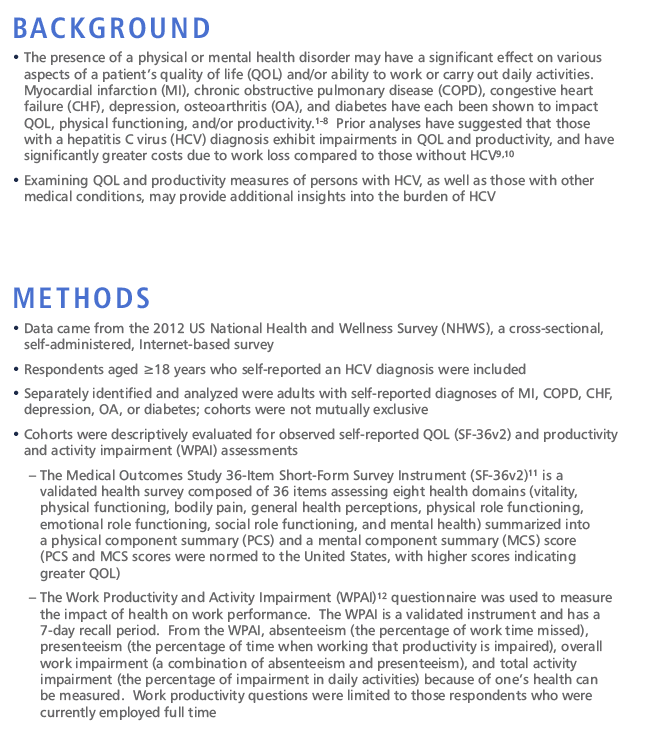
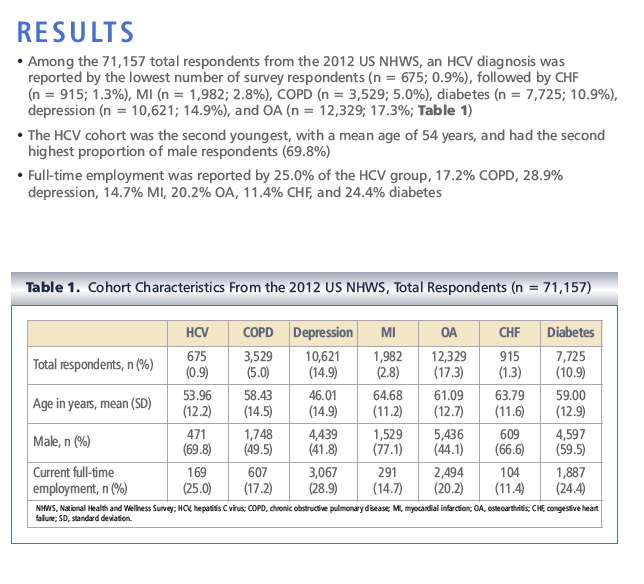
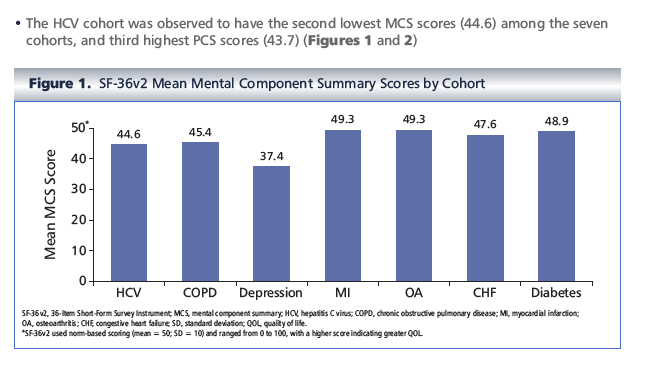
SF-36v2, 36-Item Short-Form Survey Instrument; MCS, mental component summary; HCV, hepatitis C virus; COPD, chronic obstructive pulmonary disease; MI, myocardial infarction;
OA, osteoarthritis; CHF, congestive heart failure; SD, standard deviation; QOL, quality of life.
*SF-36v2 used norm-based scoring (mean = 50; SD = 10) and ranged from 0 to 100, with a higher score indicating greater QOL.

SF-36v2, 36-Item Short-Form Survey Instrument; PCS, physical component summary; HCV, hepatitis C virus; COPD, chronic obstructive pulmonary disease; MI, myocardial infarction;
OA, osteoarthritis; CHF, congestive heart failure; SD, standard deviation; QOL, quality of life.
*SF-36v2 used norm-based scoring (mean = 50; SD = 10) and ranged from 0 to 100, with a higher score indicating greater QOL.
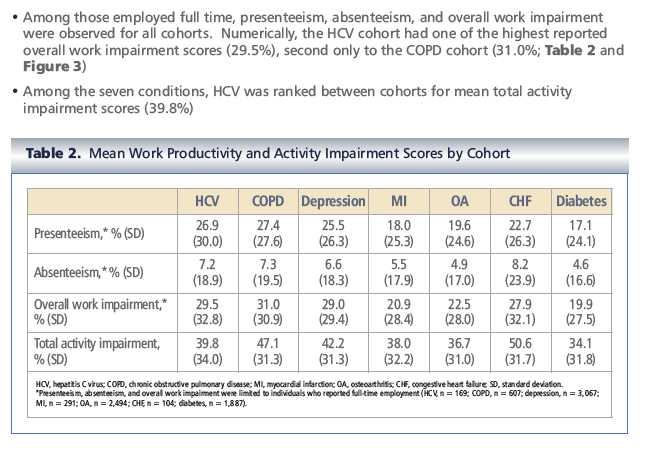
HCV, hepatitis C virus; COPD, chronic obstructive pulmonary disease; MI, myocardial infarction; OA, osteoarthritis; CHF, congestive heart failure; SD, standard deviation.
*Presenteeism, absenteeism, and overall work impairment were limited to individuals who reported full-time employment (HCV, n = 169; COPD, n = 607; depression, n = 3,067;
MI, n = 291; OA, n = 2,494; CHF, n = 104; diabetes, n = 1,887).
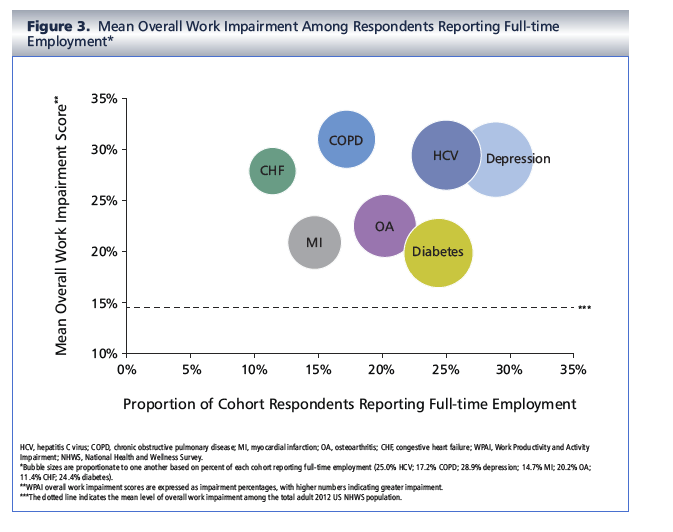
HCV, hepatitis C virus; COPD, chronic obstructive pulmonary disease; MI, myocardial infarction; OA, osteoarthritis; CHF, congestive heart failure; WPAI, Work Productivity and Activity
Impairment; NHWS, National Health and Wellness Survey.
*Bubble sizes are proportionate to one another based on percent of each cohort reporting full-time employment (25.0% HCV; 17.2% COPD; 28.9% depression; 14.7% MI; 20.2% OA; 11.4% CHF; 24.4% diabetes).
**WPAI overall work impairment scores are expressed as impairment percentages, with higher numbers indicating greater impairment.
***The dotted line indicates the mean level of overall work impairment among the total adult 2012 US NHWS population.
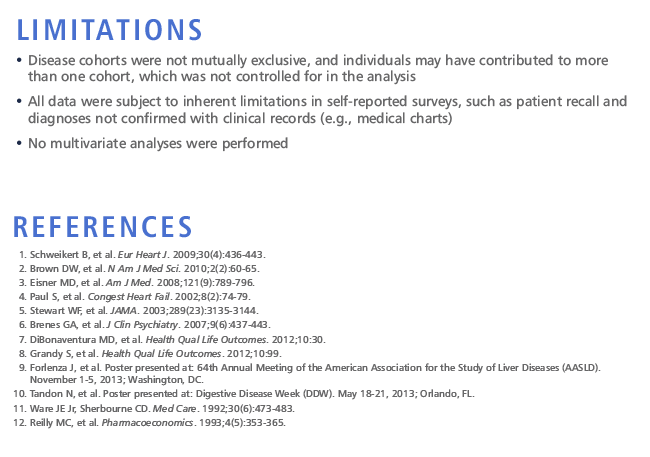
|
| |
|
 |
 |
|
|